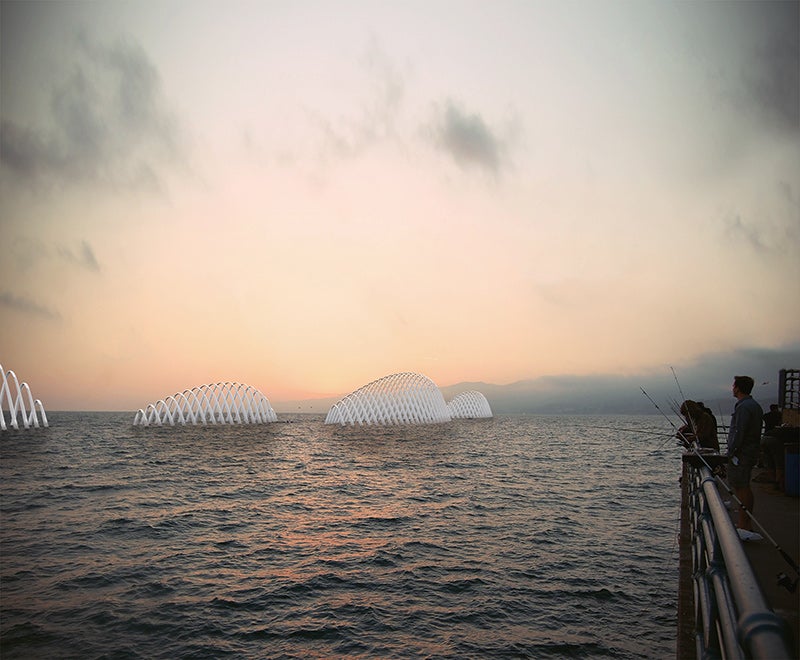Competing against professional design firms, a UO student team placed second in the international Land Art Generator Initiative (LAGI) competition to design a civic artwork that also generates carbon-free electricity and water.
The award for their project, “Cetacea,” was presented Thursday, October 6, at the Greenbuild conference in Los Angeles, California. Smithsonian.com featured the project Oct. 5.
Cetacea, a wave energy converter that incorporates wind generation and photovoltaic panels, competed against 200 entries from more than 50 countries. The project was developed by landscape architecture graduate students Keegan Oneal and Colin Poranski along with architecture undergraduates Sean Link and Caitlin Vanhauer. Their second-place win includes a $4,000 cash prize.

Above: “Cetacea” comprises wave-, wind-, and solar-powered generators within graceful arches to maximize energy production.
Another UO team entry in the LAGI competition, “Tidal 94,” placed within the top 50 and, along with Cetacea, will be featured in Powering Places: Land Art Generator Initiative Santa Monica, scheduled for release November 11, 2016, by Prestel.
Tidal 94 team members included landscape architecture undergraduates Kyle Pollack and Dylan Tiss along with architecture undergraduates Alex Collins and Ben Llewellyn.
Both teams were in senior landscape architecture instructor Anne Godfrey's spring 2016 design studio. This is the fifth year Godfrey's students have placed or been named finalists in international competitions.
Cetacea would connect to the City of Santa Monica’s water filtration plant near the city pier and provide enough electricity to run a High Efficiency Reverse Osmosis (HERO) system. Team member Sean Link said the project name was inspired by the fact that the blue whale—the largest mammal in existence—survives on plankton and krill, some of the smallest creatures in the ocean. Link also noted the whales are visible in Santa Monica Bay during migration, when “the city watches and connects to the aquatic life,” he said. Both factors informed the team’s conceptual approach.
“ ‘Cetacea’ is a multifaceted art installation that is [also] a large power house sustaining itself off the small untapped natural forces located in Santa Monica, like the blue whale,” he said. “Second, it is a bridge that connects people back to the water and its importance for life, while allowing people to create a sense of place and belonging.”

Above: Wave buoys within Cetacea float at sea level to capture wave energy, which induces electricity through an electromagnetic coil.
The Land Art Generator Initiative sponsors the competition every two years. LAGI 2016 invited artists, designers, scientists, engineers, and others to submit proposals for large-scale and site-specific public art installations that generate carbon-neutral electricity and/or drinking water for a specific site.
Cetacea comprises a “vertical configuration of wave-, wind-, and solar-powered generators within graceful, multifaceted arches [that] maximize energy production within a minimal footprint,” the team’s proposal states.
Wave buoys roughly one foot in diameter within the arches float at sea level to capture wave energy, which induces electricity through an electromagnetic coil. Windbelts™ within each arch increase wind speed to create energy. Photovoltaic panels at the top of each arch provide solar power.
“These innovative and artistic solutions that employ the latest wave, tidal, wind, solar, and water-harvesting technologies have resonance for coastal cities around the world,” LAGI founding directors Elizabeth Monoian and Robert Ferry said about the competition entries.

Above: Cetacea was developed by landscape architecture graduate students Keegan Oneal and Colin Poranski and architecture undergraduates Sean Link and Caitlin Vanhauer. Click the image above to view as larger pdf.
